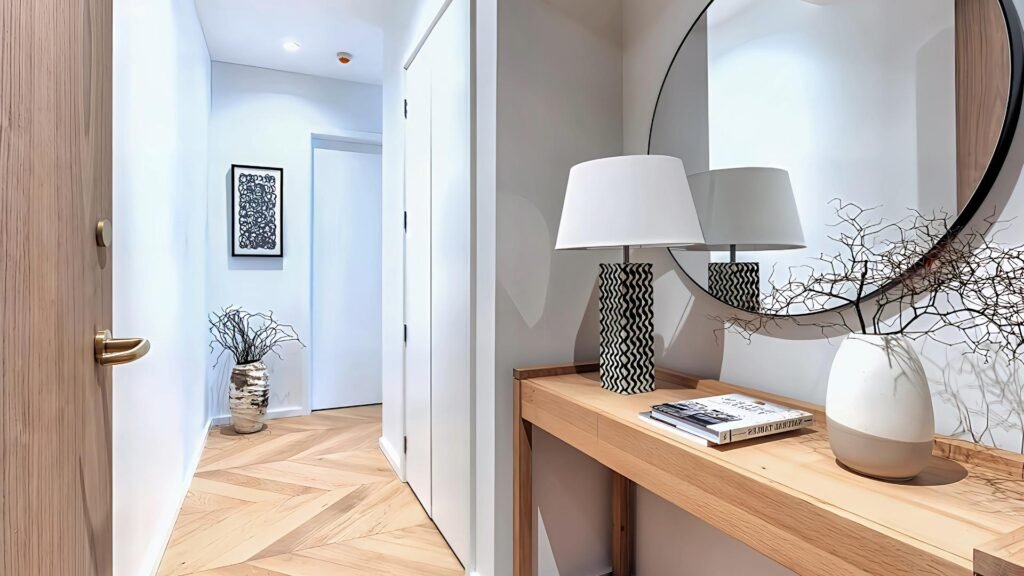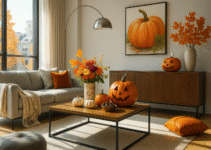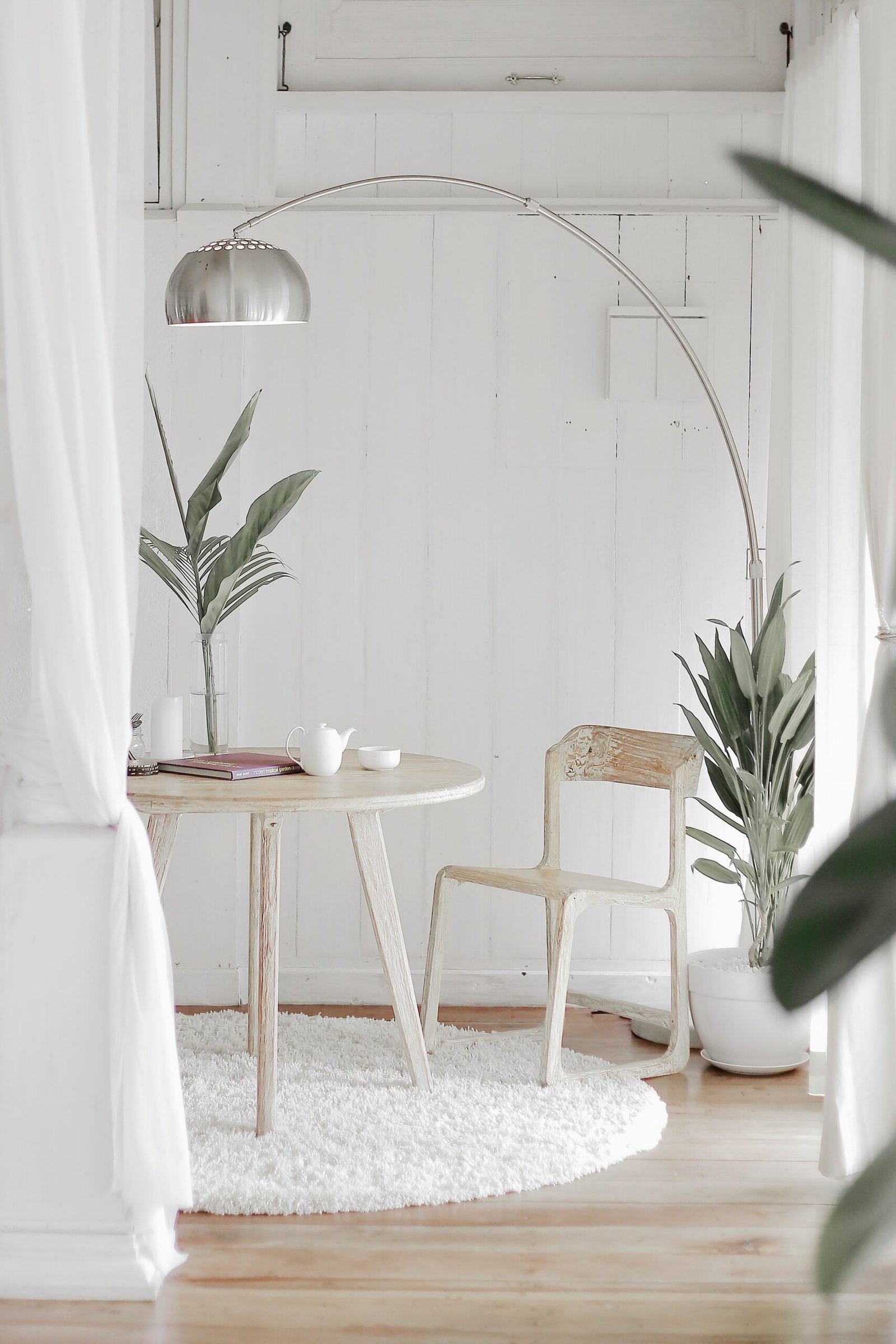Discover the serene and versatile world of white hues, neutral tones, and natural wood in interior design. Learn how to create calming spaces with white’s light-enhancing qualities, the balance of neutrals like beige and taupe, and the warmth of natural wood. With thoughtful incorporation, these elements can transform your home into a peaceful retreat, perfect for relaxation and rejuvenation.
The Serenity of White Hues
White is an often-overlooked powerhouse in the realm of interior design, renowned for its simplicity and calming qualities. The psychology behind the color white is compelling; it evokes a sense of cleanliness, freshness, and tranquility. This makes it an ideal choice for creating serene atmospheres in any living space. When incorporated thoughtfully, white can transform interiors into airy, light-filled sanctuaries that not only appear larger but also feel open and welcoming.

One of the most striking advantages of using white in interior decor is its ability to enhance natural light. White hues reflect light more effectively than other colors, which can make small or dark spaces feel significantly brighter and more expansive. By using various shades of white, such as crisp snow white, softer ivory, or creamy off-white, you can add nuanced depth and texture to your rooms without straying from a neutral palette.
Please read our article watch the newly uploaded video from our YouTube channel:
“Grig Stamate – Interior Design Solutions”
https://www.youtube.com/@GrigStamate
50 CALMING Interior Decor Solutions – White, Neutrals, and Natural Wood, #7 (video)
Here, you can see other related videos from our channel:
50 CALMING Interior Decor Solutions – White, Neutrals, and Natural Wood, #6 (video)
50 CALMING Interior Decor Solutions – White, Neutrals, and Natural Wood, #5 (video)
This neutral backdrop provides unmatched versatility when it comes to accessorizing and personalizing your space. White walls and furniture can serve as the perfect canvas for bold accent pieces or subtle decor elements. You can include colorful cushions, throws, or artwork to create a dynamic yet harmonious look. Alternatively, sticking with a monochromatic scheme by incorporating different textures—such as a white leather sofa paired with a plush white rug—can achieve a minimalist and sophisticated feel.
The use of white is not restricted to any particular room in your home. In living rooms, white can create a timeless ambiance, easily adaptable to changing trends. In kitchens, white cabinets and countertops exude cleanliness and offer a classic look. For bedrooms, soft white bed linens and drapes can evoke a sense of calm and purity, enhancing restful sleep. Bathrooms, too, benefit from white tiles and fixtures, fostering an atmosphere of relaxation and rejuvenation.
In conclusion, the myriad shades and applications of white make it an indispensable tool in crafting serene and inviting interiors. Its ability to amplify light and space, coupled with its versatility, ensures that white will continue to be a cherished choice in home decor for years to come.
Embracing Neutral Tones for Balance
In the realm of interior decor, neutral tones such as beige, taupe, and grey hold a paramount place in crafting serene and balanced living spaces. These shades serve not only as a perfect canvas for other design elements but also bring an innate sense of harmony and sophistication, ensuring the decor remains unintrusive and easy on the eyes. In a calming interior, neutrals set the stage for relaxation, making them indispensable for a well-rounded design strategy.
To create a visually intriguing yet tranquil space, consider mixing and matching different neutral hues. Combining various shades of beige, taupe, and grey can add depth and dimension to an interior, allowing the room to feel sophisticated without appearing monotonous. For instance, in a living room, pairing a soft taupe sofa with grey throw pillows and a plush beige rug can yield a cohesive and soothing aesthetic. This approach facilitates a balanced environment where each element complements rather than competes with the others.
Texture plays a significant role in enhancing neutral-toned spaces. By incorporating varied textures, such as a chunky knit throw in the bedroom, a sleek glass coffee table in the living room, or a rustic wooden shelf in the bathroom, you can elevate the interest and tactile experience of the room. This variety ensures that even without a palette of vibrant colors, the space remains engaging and comforting.
Adding subtle accents is crucial for maintaining interest within a neutral-dominated space. Elements like soft metallic finishes, gentle pops of color through accessories, or even a statement artwork can invigorate the room without overwhelming the serene ambiance. For example, a minimalist bedroom can be enhanced with a brass lamp or a gentle pastel-colored cushion, offering a quiet focal point amidst the neutral backdrop.
When applying these principles to various rooms, consider the inherent function of each space. In living areas, neutrals paired with comfortably textured upholstery encourage relaxation. Bedrooms benefit from soft, neutral bedding and gentle textures like cotton and linen, fostering an environment conducive to rest. Bathrooms, meanwhile, achieve a spa-like feel when neutrals are combined with natural materials such as wood and stone, promoting a tranquil and rejuvenating atmosphere.
The Warmth and Character of Natural Wood
Natural wood is a timeless material that inherently brings warmth and character to any interior space. Its unique grain patterns and textures create an inviting and organic atmosphere, making it a preferred choice for various decor styles. Among the most popular types of wood used in interior design are oak, walnut, pine, and reclaimed wood. Each type offers distinct characteristics that enhance the aesthetic and functionality of your home.
Oak is renowned for its robustness and durability, making it ideal for high-traffic areas like flooring and staircases. Its classic appeal fits seamlessly into both modern and traditional settings. Walnut, on the other hand, is highly valued for its rich, dark tones and smooth grain, adding sophistication to furniture pieces such as dining tables and cabinets. Pine’s light color and rustic feel make it a staple in country-style decor, often used in ceiling beams and shiplap walls. Reclaimed wood, salvaged from old structures, brings a sense of history and sustainability to interiors, offering unique patinas and weathered finishes.
The benefits of using natural wood in interior decor extend beyond aesthetics. Environmentally conscious homeowners appreciate wood’s sustainability, as it is a natural, renewable resource. Moreover, incorporating wood elements can significantly enhance indoor air quality by regulating humidity levels and reducing the presence of synthetic materials, which can off-gas harmful chemicals.
To effectively incorporate wood into your home, consider its use in various aspects such as flooring, furniture, and decorative accents. Hardwood flooring creates a consistent and elegant foundation, while wooden furniture pieces like coffee tables, bookshelves, and bed frames serve as focal points. Decorative accents, including picture frames, lamp bases, and wall art, can add subtle yet impactful touches of wood throughout a space.
Maintaining natural wood is essential to ensure its longevity and beauty. Regular dusting and cleaning with a damp cloth can prevent dirt buildup, while occasional polishing with wood-friendly products restores its natural luster. Additionally, protecting wood surfaces from excessive moisture and direct sunlight can prevent warping and fading, preserving the material’s integrity over time.
Creating a Harmonious Blend
Achieving a balanced and calming interior design involves the thoughtful integration of white, neutral tones, and natural wood. These elements individually contribute to a serene atmosphere, but their true potential is unlocked when skillfully combined. The key lies in planning and executing a cohesive design strategy that ensures each component complements the others. This section offers practical tips and strategies to help you blend these elements seamlessly.
Start by establishing a base with neutral tones. Soft grays, beiges, and whites create a versatile foundation that sets the tone for the rest of the space. To prevent the room from feeling monotonous, introduce varying shades and textures. For instance, pairing a smooth white wall with a textured beige rug can add depth and interest. Next, incorporate natural wood elements to infuse warmth and contrast. Wooden furniture or decor accessories, such as a rustic oak coffee table or a walnut bookshelf, can break up the neutrality and bring a touch of nature indoors.
Real-life examples can serve as great inspiration. For instance, a minimalist living room with white walls, a beige sofa, and an oak coffee table highlights how these elements can be harmoniously blended. Alternatively, a rustic chic dining area featuring a natural wood table, white cushions, and neutral-colored woven placemats can convey a cozy and inviting atmosphere. The balance between these elements allows you to achieve a cohesive yet dynamic design.
When selecting decor pieces, consider how each item will interact with the room’s overall palette. Opt for accessories that echo the existing colors and materials. A white ceramic vase or neutral-toned throw pillows can subtly enhance the overall harmony. Thoughtful room layouts also play a critical role; arranging furniture in a way that highlights each element ensures a balanced visual appeal.
Personal touches bring uniqueness to your space, making it feel truly yours. Incorporate personal mementos, such as family photos in wooden frames or heirloom furniture items, to create a comfortable and serene environment. The combination of white, neutrals, and natural wood can transform any room into a peaceful retreat, reflecting both tranquility and individual style.
Other related posts from our website:
Let’s see here, three of them:
We also sincerely hope you like our ideas from this post, and you have also enjoyed our uploaded YouTube video.
See you next time at another article.
Thank you so much for your time. Bye now!



No Responses